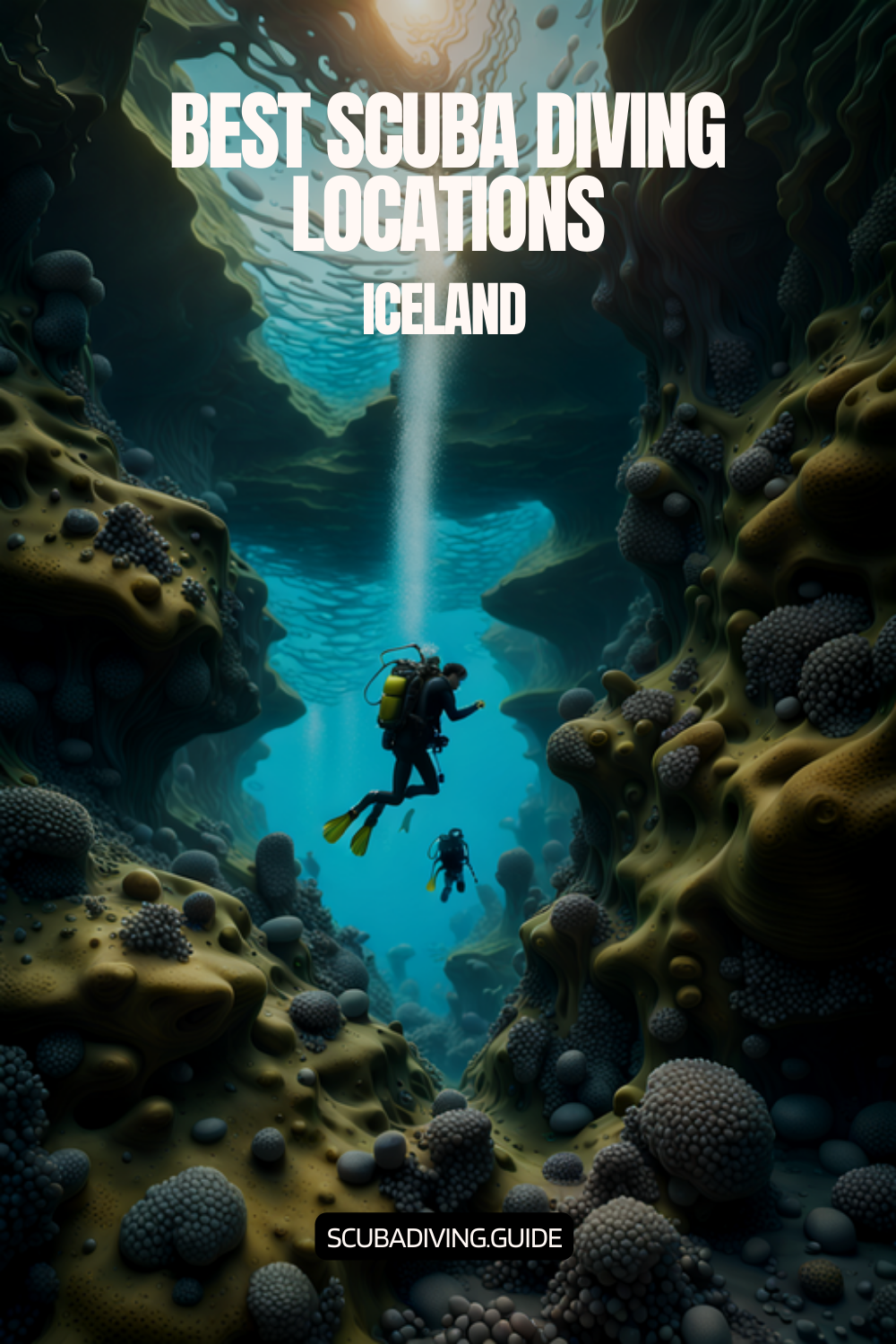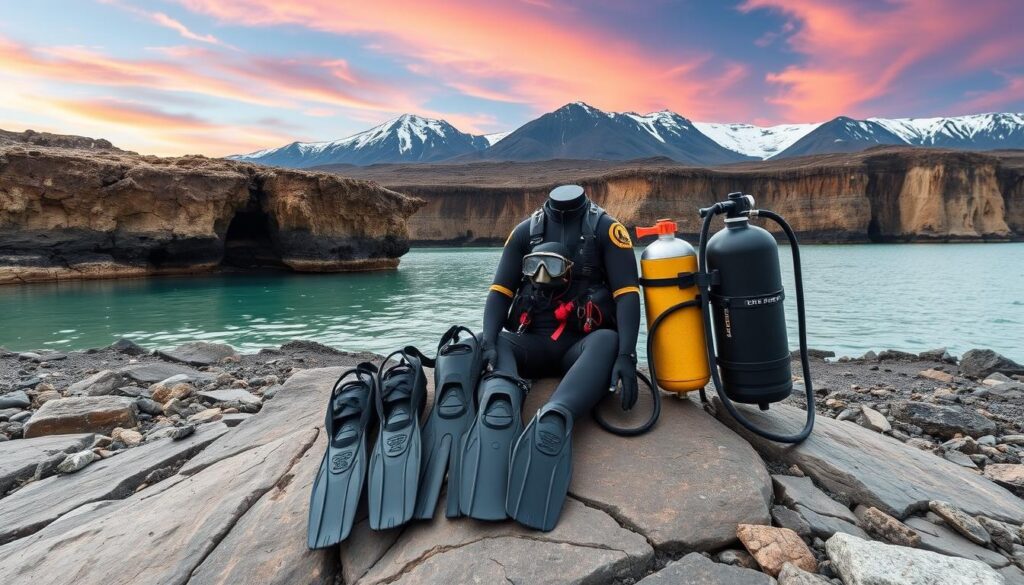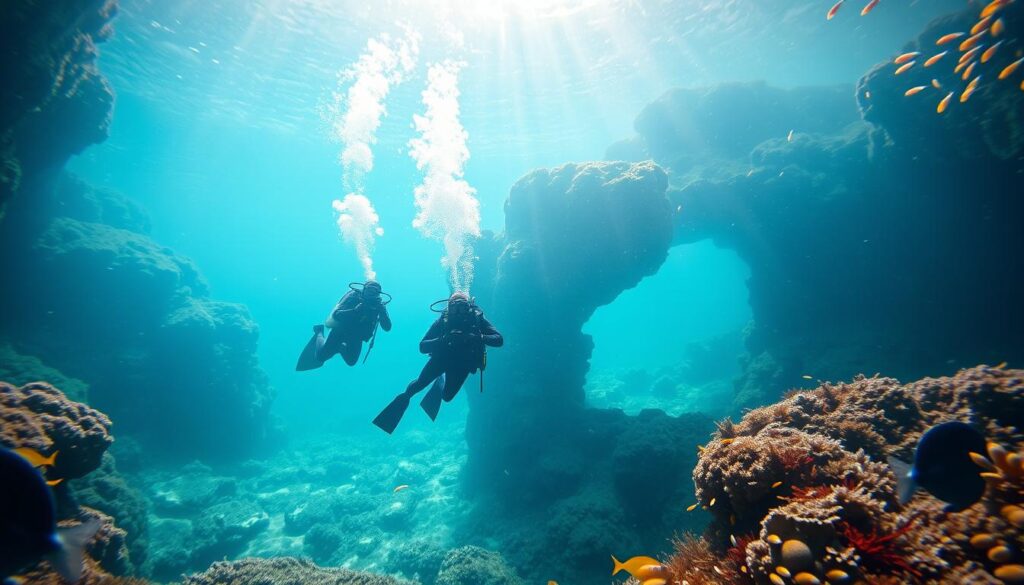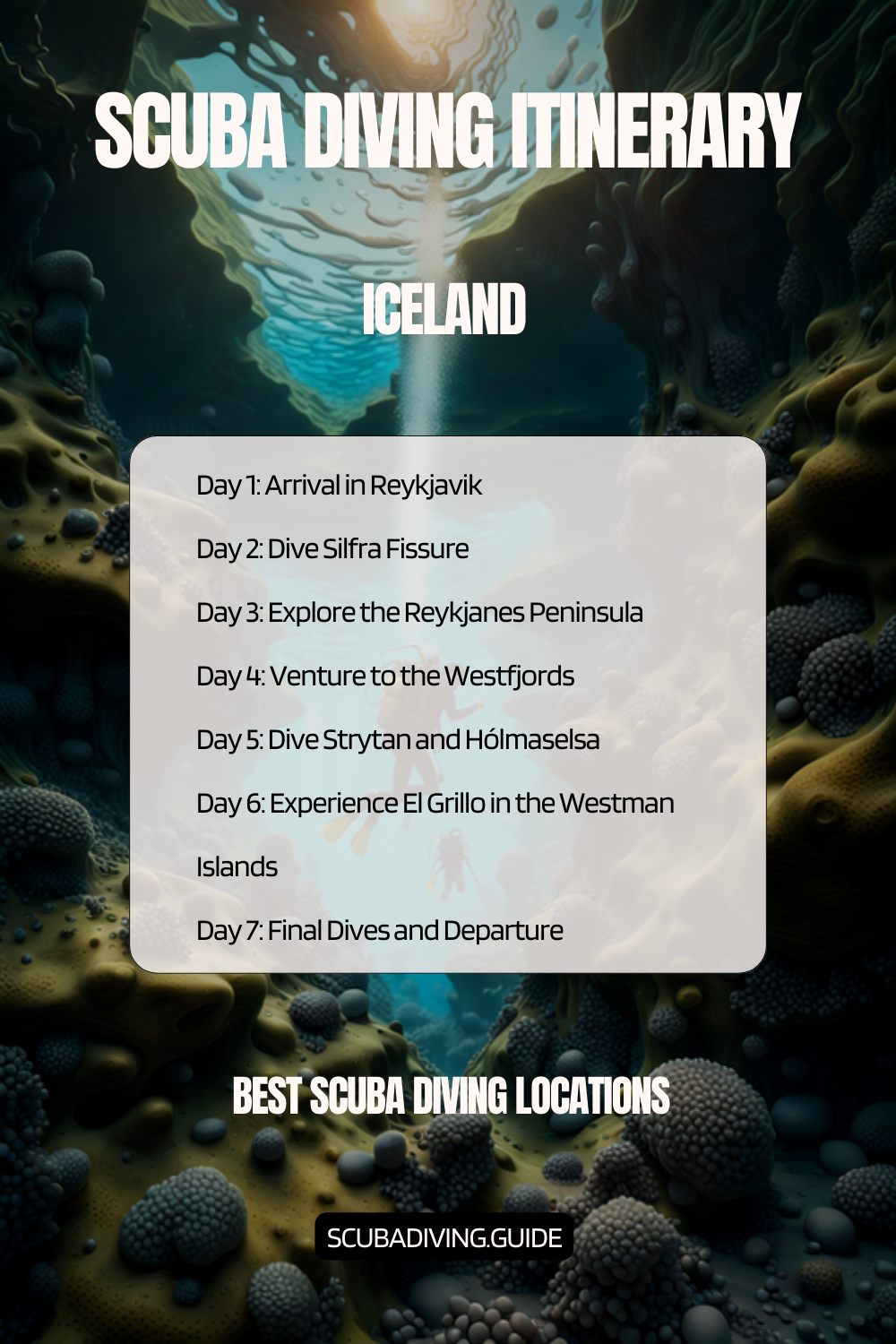| Best Time to Travel | Summer (June-August) |
| What to Expect | Cold water (32-42°F), clear visibility (up to 200 feet), unique underwater landscape |
| Diving Conditions | Year-round diving, but best during the summer (warmer water, calmer seas) |
| Marine Life | Arctic cod, lumpfish, sea urchins, jellyfish, sponges |
Ever dreamed of diving between two continents in the clearest waters? Iceland offers a unique Scuba Diving experience. It challenges everything you know about underwater adventures.
Iceland’s underwater world is mesmerizing. Here, tectonic plates meet, creating a special diving spot. The Silfra Fissure in Thingvellir National Park is where you can see this. It’s where the Eurasian and North American plates slowly move apart.
Water temperatures are cold, between 35.5-39°F. But the clear visibility, up to 100 meters, makes every dive special. It’s like a visual journey through untouched underwater beauty.
Key Takeaways – Scuba Diving in Iceland
- Dive between two continental plates in Silfra Fissure
- Experience world-class underwater visibility
- Explore unique geological formations
- Challenge yourself in cold-water diving conditions
- Discover Iceland’s remarkable underwater landscapes

Why Choose Scuba Diving in Iceland?
Iceland offers a unique cold water diving experience unlike anywhere else. Its underwater landscapes and diving opportunities are a dream for scuba enthusiasts.
Diving in Iceland is a challenge and an inspiration for all divers. The natural features create a magical diving environment.
Unique Underwater Landscapes
Diving in Silfra Fissure is a once-in-a-lifetime chance. It’s the only spot where divers can see a crack between two tectonic plates. The underwater terrain features:
- Volcanic rock formations
- Crystal-clear water with visibility up to 100 meters
- Dramatic geological landscapes
“Diving in Silfra is like floating through liquid glass between two continental plates.” – Diving Enthuasiast
Rich Marine Life
Iceland’s cold waters are home to fascinating organisms. Divers can see:
- Colorful algae formations
- Unique cold-water marine species
- Intricate underwater ecosystems
Unforgettable Experiences
Silfra Fissure Diving gives you bragging rights and unforgettable memories. Water temperatures are between 2-4°C, and visibility is up to 90 meters, making each dive an adventure.
TripAdvisor rated snorkeling in Silfra Fissure as one of the top 5 activities globally in 2019, underscoring its remarkable appeal.
Best Locations for Scuba Diving
Iceland’s underwater world is breathtaking, attracting divers globally. From clear fissures to dramatic marine scenes, Reykjavik Scuba Diving offers unique dives. Each spot showcases Iceland’s incredible geological wonders.
Silfra Fissure: A Geological Wonder
Þingvallavatn Lake Diving peaks at Silfra Fissure, in Thingvellir National Park. This dive site is between two tectonic plates. Divers can touch two continents in one dive.
- Visibility exceeding 100 meters
- Water temperature ranges from 2-4°C
- Located 50 km northeast of Reykjavik
- Rated as a top 5 global dive site
Reykjanes Peninsula: Diverse Diving Experiences
The Reykjanes Peninsula offers varied underwater worlds for scuba fans. Divers can see both freshwater and ocean sites. They can also find unique marine life.
| Dive Site | Depth Range | Water Temperature |
|---|---|---|
| Reykjanes Ocean Dive | 10-40 meters | 7-12°C |
| Geothermal Sites | 15-30 meters | 6-8°C |
Akureyri Diving Sites: Northern Iceland’s Hidden Gems
Akureyri in northern Iceland offers unique diving spots. Here, cold-water marine life gives glimpses of Arctic creatures. These dives need advanced skills and warm gear.
“Diving in Iceland is not just a sport, it’s an adventure through living geological history.”
Divers face tough conditions but get to see Iceland’s amazing underwater views.
What to Expect When Diving in Iceland
Diving in Iceland is an amazing underwater adventure. It combines geological wonders with extreme natural conditions. The unique Northern Lights Underwater environment is a challenge for even the most experienced divers.
Before diving in Iceland, you need to know about its special conditions. This makes it a truly unique place for diving.
Water Temperature and Thermal Challenges
Geothermal Diving in Iceland is a unique thermal experience. The water is usually between 2°C to 4°C (36°F to 39°F). You’ll need special equipment and preparation:
- Mandatory dry suit certification
- Thermal protection layers
- Specialized cold-water diving gear
Visibility and Underwater Landscape
Iceland’s underwater environments have amazing visibility. Places like Silfra Fissure stand out:
| Location | Visibility Range | Unique Feature |
|---|---|---|
| Silfra Fissure | 100 meters (330 feet) | Tectonic plate boundary |
| Reykjanes Peninsula | 50-80 meters | Geothermal underwater formations |
Dive Duration and Depth Considerations
Diving in Iceland needs careful planning because of the cold water:
- Typical dive duration: 30-40 minutes
- Maximum recommended depth: 18-20 meters
- Recommended surface intervals: Minimum 30 minutes
“Diving between tectonic plates is a once-in-a-lifetime experience that transforms your understanding of our planet’s geological dynamics.” – Arctic Diving Experts
Pro tip: Always check your diving certification. Make sure you have the right experience for cold-water diving in Iceland.
Essential Scuba Gear for Iceland
When diving in Iceland’s cold waters, you need special gear. This gear is more than what you’d use in warm waters. It’s all about staying safe and comfortable in icy conditions.

Wetsuits vs. Dry Suits: The Critical Difference
In Iceland’s icy waters, dry suits are a must. The water is always between 2°C and 4°C. Dry suits are key for keeping warm and keep your body dry.
- BARE XCD2 Pro Dry suits (compressed neoprene)
- Thermal undergarment: BARE C-200
- Recommended: Two thermal layers for maximum insulation
Recommended Accessories for Cold Water Diving
Having the right accessories is vital for safe diving in Iceland. The marine environment can be tough.
| Accessory | Specifications | Purpose |
|---|---|---|
| Hood | BARE 7mm Neoprene | Thermal head protection |
| Gloves | BARE 7mm Neoprene | Hand warmth and grip |
| Mask | BARE, Aqualung, Cressi | Clear vision underwater |
Equipment Rental Options
Most diving tours in Iceland offer top-notch rental gear. This gear meets strict safety standards. You can rent everything you need, including:
- Scuba tanks (12 or 15 liters)
- Buoyancy Control Devices (BCDs)
- Regulators
- Fins and masks
“Proper equipment is not just about comfort—it’s about survival in Iceland’s extreme underwater conditions.”
If you’re new to Cold Water Diving, many operators help. They offer gear orientation and dry suit training. This ensures you’re ready for diving in Iceland.
Safety Considerations for Diving
Diving in Iceland’s underwater worlds needs careful planning and strict safety rules. Volcanic and glacier diving are special challenges that require expert knowledge and careful steps.
Exploring underwater in Iceland requires knowing key safety steps. The changing weather of volcanic and glacier diving needs a solid safety plan.
Weather Condition Assessment
Checking the weather before diving is very important. Iceland’s weather can change fast, affecting diving safety. Divers should:
- Check official marine weather forecasts
- Monitor wind speeds and wave conditions
- Understand local maritime safety reports
- Consult experienced local dive guides
Buddy System Importance
The buddy system is very important in tough diving spots like volcanic and glacier areas. It ensures support and help in emergencies.
“In cold water diving, your buddy is your lifeline” – Professional Diving Association
Emergency Procedure Guidelines
| Scenario | Recommended Action |
|---|---|
| Equipment Failure | Immediate surface ascent with buddy assistance |
| Medical Emergency | Activate emergency communication protocol |
| Unexpected Environmental Change | Follow pre-planned exit strategy |
Diving depth in places like Silfra is limited to 18 meters. Knowing and following these rules keeps divers safe in Iceland’s underwater worlds.
Certification Requirements
Getting ready for Scuba Diving in Iceland means paying attention to certification and personal readiness. Knowing the specific requirements is key for a safe and memorable dive in this unique place.
Dive Certification Levels
For Scuba Diving in Iceland, you need to meet certain standards:
- Minimum Open Water Diver certification from recognized organizations
- Dry suit diving certification or proof of 10 logged dry suit dives
- Minimum age requirement of 18 years old
Local Dive Schools and Courses
Reykjavik Scuba Diving has many certification options through local dive schools. These schools offer detailed training programs. They prepare divers for Iceland’s special underwater worlds.
| Certification Type | Requirements | Duration |
|---|---|---|
| Open Water Diver | No prior experience | 3-4 days |
| Dry Suit Specialty | Open Water certification | 1-2 days |
| Advanced Open Water | Open Water certification | 2-3 days |
First-Time Divers Tips
For those diving in Iceland for the first time, here are some tips:
- Complete a medical self-check form before diving
- Practice swimming and physical fitness
- Take a pre-trip dry suit orientation course
- Understand water temperatures range from 36°F to 39°F
“Preparation is key to an unforgettable underwater adventure in Iceland’s crystal-clear waters.”
Divers need to be physically fit. They should be able to swim 500 meters and walk 600 meters. Those over 60 or with certain health issues need extra health checks before diving in Reykjavik.
Fascinating Underwater Flora and Fauna
Iceland’s underwater world is a mesmerizing place. It turns underwater exploration into an amazing adventure. The unique marine ecosystem offers divers a special experience unlike any other diving spot.
Silfra Fissure Diving shows a breathtaking underwater world. It has remarkable geological and biological features. The marine ecosystem is home to fascinating species and formations that attract underwater lovers.
Cold-Water Species to Spot
Divers in Iceland’s underwater world can see a variety of marine life. This life is adapted to cold temperatures:
- Arctic char
- Sea stars
- Various crustacean species
- Occasional jellyfish
Unique Rock Formations
The underwater landscape has extraordinary geological structures. Areas like Silfra Fissure are famous for these. Divers can see the spectacular divide between tectonic plates, creating otherworldly rock formations.
| Location | Unique Feature | Depth Range |
|---|---|---|
| Silfra Fissure | Tectonic Plate Divide | 0-18 meters |
| Bjarnagja Rift | Underwater Geological Formations | Up to 18 meters |
| Gardur Diving Spot | High Algae Biodiversity | Varies |
Bioluminescent Organisms
Some divers might see bioluminescent organisms. These glowing creatures make diving in Iceland magical. They add an ethereal touch to the underwater experience.
“Diving in Iceland is not just an activity, it’s a journey through a living, breathing underwater world.” – Icelandic Marine Biologist
Cultural Insights: Diving and Local Life
Scuba Diving in Iceland is more than just exploring the sea. It connects us to Iceland’s rich maritime history. The tradition of underwater exploration in Iceland goes back a long way, thanks to a long history of seafaring.

Icelandic Diving Traditions
The story of diving in Iceland started in 1966. A teacher from Reykjavík’s Seafaring School brought diving skills from the United States. Ever after, diving became a cherished part of Icelandic culture, linking people to their beautiful marine surroundings.
- Diving first introduced in the late 1960s
- Rooted in maritime exploration traditions
- Reflects Iceland’s deep connection to the ocean
Connecting with Local Divers
In Iceland, diving communities offer special chances for all divers. Icelandic Underwater Exploration is about more than just diving. It’s about making friends and sharing stories with local diving experts.
“In Iceland, diving is more than a sport. It’s a way of understanding our connection to the natural world.” – Local Dive Instructor
Ethical Diving Practices
Responsible diving is key in Iceland’s fragile underwater worlds. Local divers focus on keeping the sea safe. They dive in a way that respects the marine life and the sea itself.
- Respect marine life habitats
- Follow local conservation guidelines
- Minimize underwater disturbance
By following these values, divers can enjoy Iceland’s amazing underwater world. They also help protect it for future generations.
Guided vs. Independent Diving
Scuba diving in Iceland lets you see amazing underwater worlds. You can choose between guided tours or diving on your own. This choice can really change your dive experience in this unique place.
Benefits of Guided Tours
Reykjavik Scuba Diving tours are great for both new and seasoned divers. Guides share their local knowledge and keep you safe in tricky underwater spots.
- Expert navigation through complex underwater terrain
- Comprehensive safety briefings
- High-quality equipment provided
- Insights into local marine ecosystems
Planning Independent Dives
For those with lots of diving experience, diving on your own lets you explore freely. But, you must plan well to have a good dive.
- Obtain necessary permits
- Verify local diving regulations
- Check weather conditions
- Confirm equipment functionality
Combining Diving Approaches
Smart divers mix guided and independent dives for the best underwater adventure.
| Diving Approach | Recommended For | Average Cost |
|---|---|---|
| Guided Tours | Beginners/Intermediate | $255-$307 USD |
| Independent Dives | Experienced Divers | Equipment Rental Costs |
| Hybrid Approach | All Skill Levels | Varies |
“The ocean is a magnificent classroom, and Iceland offers an extraordinary diving curriculum.”
Photography Tips for Underwater Shots
Capturing the magical world of Icelandic Underwater Exploration needs special skills and gear. The clear waters of Silfra Fissure Diving offer unique chances for underwater photographers. They seek stunning marine images.
Choosing the Right Camera for Underwater Photography
Finding the right underwater camera is key. It’s about knowing depth ratings and marine photography needs. Experts suggest a few top choices:
- GoPro HERO series (waterproof to 10 meters)
- SeaLife Micro 3.0 (capable of 60 meters depth)
- Specialized underwater smartphone cases
Essential Techniques for Crystal-Clear Images
Underwater photography needs special techniques for clear marine shots. Important strategies include:
- Use external strobes for better lighting
- Keep camera 2-3 feet from subjects
- Use macro mode for close-up shots
- Adjust white balance for true colors
| Camera Type | Depth Rating | Price Range |
|---|---|---|
| Smartphone with Case | 15 meters | $50-$250 |
| GoPro | 10 meters | $300-$500 |
| Professional DSLR Housing | 60 meters | $1,000-$3,000 |
Highlighting Icelandic Marine Environments
Silfra Fissure Diving is a photographer’s dream. It offers unmatched underwater visibility. Focus on unique geological formations, algae colors, and the mystical underwater landscapes of Iceland’s marine ecosystems.
“The underwater world of Iceland is not just a view, it’s an experience waiting to be photographed.” – Professional Underwater Photographer
Remember, post-processing can turn good underwater images into amazing stories of your Icelandic Underwater Exploration.
Environmental Responsibility in Diving
Scuba diving in Iceland offers breathtaking underwater experiences. But, it comes with a big responsibility to protect marine ecosystems. Every diver must commit to preserving these delicate underwater environments.
Importance of Conservation
Marine ecosystems face big challenges from human activities. Research shows alarming statistics about these threats:
- 80% of ocean surfaces are affected by pollution
- 46% of marine species impacted by plastic waste
- Approximately 12,000-24,000 tons of plastic ingested by marine animals annually
- 60% of coral reefs at risk from human intervention
Eco-Friendly Diving Practices
Geothermal diving in Iceland needs special care. Divers can reduce their impact by:
- Maintaining perfect buoyancy control
- Using environmentally friendly diving equipment
- Avoiding contact with marine life and geological formations
- Practicing strict “leave no trace” principles
Supporting Local Conservation Efforts
Iceland’s marine conservation needs everyone’s help. Dive operators with sustainable practices can cut environmental impact by up to 30%. Divers can help by:
| Conservation Activity | Potential Impact |
|---|---|
| Beach Clean-ups | 75% reduction in beach litter |
| Environmental Education | 40% increase in responsible diving practices |
| Supporting Local Organizations | Direct contribution to marine ecosystem protection |
“Our oceans are not a resource, they are a responsibility.”
By taking environmental responsibility, divers can protect Iceland’s underwater wonders. This way, future generations can enjoy these amazing landscapes too.
Dive Packages and Pricing
Planning your Scuba Diving in Iceland adventure means looking at different prices. Reykjavik Scuba Diving has many packages for all budgets and tastes.
Cost Breakdown for Diving Experiences
Prices for diving tours in Iceland change based on several things. Here’s a simple guide:
- Wetsuit Snorkeling Trip: About 136 USD (4.5-hour experience)
- Wetsuit Freedive Trip: Around 174 USD (3-hour experience)
- Guided Drysuit Tour: Roughly 212 USD (3-hour guided experience)
Group Discounts and Special Offers
Groups can save money on diving. Most places offer:
- Small group tours (6-8 divers per guide)
- Multi-day booking packages
- Early booking discounts
What’s Included in Dive Packages
Dive packages in Iceland usually include a lot:
- Professional guide services
- Essential diving equipment rental
- National Park entrance fees (1,500 ISK per participant)
- Safety briefing and instructions
“The crystal-clear waters of Iceland offer an unparalleled diving experience that’s worth every penny!” – Experienced Dive Instructor
More things to think about for Reykjavik Scuba Diving packages include:
- Age restrictions (usually 18+, but some tours allow 12+ with consent)
- Certification needs (PADI Open Water Diver or similar)
- Recommended diving insurance
Pro tip: Book early in peak season (June to August) for the best prices and spots for your Icelandic diving trip!
Post-Dive Activities and Attractions
After your Icelandic Underwater Exploration, the fun doesn’t stop. Thingvellir National Park, where Silfra is located, has more to see and do. The area’s volcanic landscapes are as fascinating as the underwater world.
The Golden Circle route is a great way to extend your dive trip. You’ll see the stunning Gullfoss waterfall and the Geysir hot spring area. These spots show off Iceland’s unique nature.
Exploring Nearby Natural Wonders
Thingvellir National Park is a UNESCO World Heritage Site. It has amazing hiking trails and historical sites. You can walk between the North American and Eurasian tectonic plates, just like in Silfra.
The park’s varied landscapes are perfect for photography and exploring nature. It’s a great place to see the beauty of Iceland.
Cultural Sites to Visit
For cultural experiences, check out local museums and historical sites in Reykjavík. They offer a deep look into Icelandic heritage. These places are close to the dive sites, making it easy to explore both underwater and on land.
Dining and Relaxation Options
After diving, relax at local geothermal spas and enjoy traditional Icelandic food. The seafood and local dishes are a great match for your underwater adventures. Your trip will be both tasty and thrilling.
Iceland Recommended Scuba Diving Itinerary
Planning a scuba diving trip to Iceland requires careful consideration of the country’s diverse dive sites and unique geographical features. To make the most of your diving adventure, we have crafted a recommended scuba diving itinerary that combines some of the best dive sites Iceland has to offer.
Day 1: Arrival in Reykjavik
Begin your Icelandic diving journey by arriving in Reykjavik, the capital city. Take some time to settle into your accommodations and explore the vibrant city center. Enjoy a relaxing evening, preparing for the exciting dives ahead.
Day 2: Dive Silfra Fissure
Start your diving itinerary with a visit to Silfra Fissure in Thingvellir National Park. Experience the remarkable visibility and swim between the Eurasian and North American tectonic plates. Marvel at the stunning rock formations and enjoy the surreal beauty of this world-renowned dive site.
Day 3: Explore the Reykjanes Peninsula
Embark on a day of diving along the Reykjanes Peninsula. Discover the underwater landscapes of Kleifarvatn, known for its submerged lava fields and hidden hot springs. Continue to Garður, where vibrant kelp forests and an abundance of marine life await.
Day 4: Venture to the Westfjords
Travel to the remote and captivating Westfjords region. Dive in Djúpavík, exploring underwater cliffs, fascinating rock formations, and encountering a variety of marine species. Immerse yourself in the rugged and untouched beauty of this area.
Day 5: Dive Strytan and Hólmaselsa
Continue your Westfjords exploration with dives at Strytan and Hólmaselsa. Strytan’s unique geothermal chimneys attract diverse marine life, while Hólmaselsa offers underwater canyons and rugged rock formations to discover.
Day 6: Experience El Grillo in the Westman Islands
Head to the Westman Islands (Vestmannaeyjar) and dive at El Grillo. Explore the stunning underwater cliffs, encounter playful seals, and witness the vibrant marine ecosystems that thrive in this area.
Day 7: Final Dives and Departure
Conclude your diving adventure with additional dives at your preferred locations or revisit any dive sites that captivated you during your journey. After the dives, take some time to reflect on your incredible experiences before departing from Iceland.
This recommended itinerary provides a well-rounded exploration of Iceland’s diverse underwater landscapes and allows divers to experience some of the country’s most iconic dive sites. However, it is important to note that weather and diving conditions can vary, so flexibility is key when planning your dives. It is advisable to consult with local diving centers, stay updated on weather forecasts, and make adjustments to your itinerary accordingly.
Remember to prioritize safety, adhere to diving regulations, and respect the fragile marine environment during your dives. Iceland’s underwater world offers a unique and awe-inspiring experience, and following responsible diving practices ensures its preservation for future generations of divers to enjoy.

Other Countries to Consider
FAQ – Scuba Diving in Iceland
What makes scuba diving in Iceland unique?
Iceland offers amazing diving spots, like Silfra Fissure. Here, you can dive between tectonic plates in water as clear as 100 meters. You’ll see unique volcanic rocks and glacial waters.
It’s a rare chance to dive between the North American and Eurasian plates.
Do I need special certification for diving in Iceland?
You need an Open Water and dry suit certification for Iceland’s cold waters. Dive operators look for cold water and dry suit experience. Temperatures are 2-4°C (36-39°F).
What should I wear for diving in Iceland?
A dry suit is key for diving in Iceland. Wear thermal undergarments, thick gloves, a hood, and a cold water mask. Dive operators often rent out equipment, but your own gear is safer.
When is the best time to go scuba diving in Iceland?
The best time is June to September for more daylight and stable weather. Winter diving is unique, with Northern Lights, but it’s more challenging.
What marine life can I expect to see while diving in Iceland?
Iceland’s waters have unique species like “troll hair” algae and colorful fish. The underwater world is diverse, with vibrant colors and formations. Each dive is a new adventure.
How much does scuba diving in Iceland typically cost?
Dive prices vary. A single dive at Silfra costs $150-$300. Multi-day packages are $300-$800, including gear and guides.
Is diving in Iceland safe for beginners?
While challenging, many operators offer beginner-friendly dives. Beginners should have cold water experience and know dry suit diving.
Can I take underwater photographs during my dive?
Yes! Iceland’s clear waters are perfect for photos. You’ll need a cold water camera housing and know-how. Many tours are designed for photography.
What are the most famous diving locations in Iceland?
Top spots include Silfra Fissure, Reykjanes Peninsula, and Akureyri. Each offers unique dives, from tectonic plate to volcanic formations.
How cold are the waters during a dive in Iceland?
Water temperatures are 2-4°C (36-39°F) all year. A dry suit and proper undergarments are essential for a safe dive.